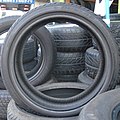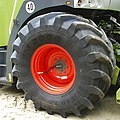- Automobile tires
- Studded winter tire
- Formula One racing slicks
- Large tires
- Airless tires
- Aircraft tire
- Motorcycle tire
- Mountain bike tires
- Spiked tire
- Tractor tire
The following outline is provided as an overview of and topical guide to tires:
Contents
- Tire Industry History
- Types
- By construction
- By tread
- By appearance
- Vehicle specific
- Use specific
- Components and materials
- Attributes
- Behaviors
- Maintenance
- Inflation
- Tools
- Life cycle
- Failure
- Organizations
- Manufacturing Companies
- Standards
- Technical
- Identification
- Regulation and Standards
- See also
- References
- External links
Tire (North American) or tyre (British) – ring-shaped covering that fits around a wheel rim to protect it and enable better vehicle performance by providing a flexible cushion that absorbs shock while keeping the wheel in close contact with the ground.









